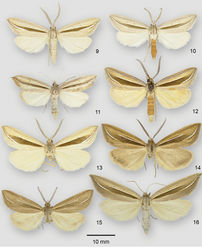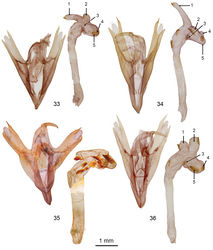Doryodes fusselli
| Notice: | This page is derived from the original publication listed below, whose author(s) should always be credited. Further contributors may edit and improve the content of this page and, consequently, need to be credited as well (see page history). Any assessment of factual correctness requires a careful review of the original article as well as of subsequent contributions.
If you are uncertain whether your planned contribution is correct or not, we suggest that you use the associated discussion page instead of editing the page directly. This page should be cited as follows (rationale):
Citation formats to copy and paste
BibTeX: @article{Lafontaine2015ZooKeys, RIS/ Endnote: TY - JOUR Wikipedia/ Citizendium: <ref name="Lafontaine2015ZooKeys">{{Citation See also the citation download page at the journal. |
Ordo: Lepidoptera
Familia: Erebidae
Genus: Doryodes
Name
Doryodes fusselli Sullivan & Lafontaine sp. n. – Wikispecies link – ZooBank link – Pensoft Profile
Type material
Holotype ♂, North Carolina, New Hanover Co., Fort Fisher Maritime Forest, A trail, 775504 W 335833 N, 15 Watt UV trap, Coastal fringe Evergreen Forest, June 3, 1995, J. Bolling Sullivan, Richard Broadwell & Brad Smith. USNM. Paratypes: 8 ♂, 4 ♀. North Carolina. Same data as for holotype (2 ♂, 2 ♀); same locality and collector as holotype, June 27, 1995 (1 ♂, 1 ♀), April 19, 1995 (1 ♂), November 8, 1994 (1 ♂), October 5, 1994 (1 ♀). North Carolina, Carteret Co., Ft Macon State Park, 15 July 1999 (1 ♂); Carteret Co., maritime scrub, N34.697°, W-76.683°, 29 Aug. 2005, J. Bolling Sullivan, barcodes 05-NCCC-523, & 05-NCCC-524 (2 ♂). BIO, CNC, JBSC, USNM.
Etymology
The species name is in honor of John Fussell from Morehead City, North Carolina, who has worked tirelessly for decades to describe and protect the unique flora and fauna of the North Carolina coastal plain, particularly the Croatan National Forest. All of our lives are richer for his efforts.
Diagnosis
This species occurs with Doryodes spadaria in the salt marshes and tidal creeks throughout coastal North Carolina Adults are slightly larger than Doryodes bistrialis, but noticeably smaller (especially females) than Doryodes spadaria. The medial chocolate stripe on the forewing is broader than in Doryodes bistrialis, but narrower than that of Doryodes spadaria. Spring males are larger than those of the summer and fall generations, so they are more easily confused with Doryodes spadaria. The hind wing is white, without the buff coloring of Doryodes spadaria; in late summer some males of Doryodes spadaria can have white hind wings, but size ranges for the two species do not overlap in this generation. Similar changes in size with season are seen for many other species (Sullivan and Miller 2007[1]). The vesica differs in having a diffuse line of cornuti along the basal trunk and by the symmetrical pair of cornuti-tipped diverticula at the apex. Doryodes spadaria is described in full, so only differences from it are given in the description.
Description
Smaller than Doryodes spadaria; spring males (forewing length: 16–17 mm [16–20 mm for Doryodes spadaria]), slightly larger than summer males (forewing length: 14–15 mm); some small individuals (forewing length: 12–13 mm) late in season; females of Doryodes fusselli (forewing length: 16 mm) smaller than those of Doryodes spadaria (forewing length: 18–21 mm) but larger than those of Doryodes bistrialis. Hindwing pearly white. Male genitalia with valves similar to those of Doryodes spadaria but slightly smaller (valve length: 4.45 mm versus 4.75 mm for Doryodes spadaria). Vesica basal trunk with single band of cornuti, usually separated into two elongated sections; diverticulum 1 rounded with toothed, rooster-comb-like cornutus on dorsal side; diverticulum 2 rounded, about 1.0–1.5 × as long as wide, with triangular cornutus on ventral surface near apex; terminus of vesica with two similar cornuti-tipped diverticula projecting distally [in Doryodes spadaria two terminal diverticula are more elongated, different in shape from each other, and project laterally]. Female genitalia differ from those of Doryodes spadaria in more even width of ductus bursae, and appendix bursae more elongated with posterior margin even, not bilobed as in Doryodes spadaria.
Distribution and biology
At present this species is known only from North Carolina, occurring from Dare County in the north to Brunswick and New Hanover counties in the south. It is likely that it occurs farther south but may have been overlooked as Doryodes spadaria. Specimens have been collected from April through October and the species appears to be on the wing continuously. Eggs were obtained from a female and fed cut Spartina alterniflora Loisel. leaves and fresh and wilted Bermuda grass. The larvae survived to the second instar and were similar to those of Doryodes spadaria (Wagner et al. 2011[2]). Larvae have not been located in the field.
Original Description
- Lafontaine, J; Sullivan, J; 2015: A revision of the genus Doryodes Guenée, 1857, with descriptions of six new species (Lepidoptera, Erebidae, Catocalinae, Euclidiini) ZooKeys, (527): 3-30. doi
Images
|
Other References
- ↑ Sullivan J, Miller W (2007) Intraspecific body size variation in macrolepidoptera as related to altitude of capture site and seasonal generation. Journal of the Lepidopterists’ Society 61: 72–77.
- ↑ Wagner D, Schweitzer D, Sullivan J, Reardon R (2011) Owlet caterpillars of eastern North America (Lepidoptera: Noctuidae). Princeton University Press, 576 pp.


